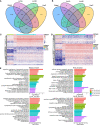Identifying enhancer-driven subtype-specific prognostic markers in breast cancer based on multi-omics data
- PMID: 36304471
- PMCID: PMC9592759
- DOI: 10.3389/fimmu.2022.990143
Identifying enhancer-driven subtype-specific prognostic markers in breast cancer based on multi-omics data
Abstract
Breast cancer is a cancer of high complexity and heterogeneity, with differences in prognosis and survival among patients of different subtypes. Copy number variations (CNVs) within enhancers are crucial drivers of tumorigenesis by influencing expression of their targets. In this study, we performed an integrative approach to identify CNA-driven enhancers and their effect on expression of target genes in four breast cancer subtypes by integrating expression data, copy number data and H3K27ac data. We identified 672, 555, 531, 361 CNA-driven enhancer-gene pairs and 280, 189, 113 and 98 CNA-driven enhancer-lncRNA pairs in the Basal-like, Her2, LumA and LumB subtypes, respectively. We then reconstructed a CNV-driven enhancer-lncRNA-mRNA regulatory network in each subtype. Functional analysis showed CNA-driven enhancers play an important role in the progression of breast cancer subtypes by influencing P53 signaling pathway, PPAR signaling pathway, systemic lupus erythematosus and MAPK signaling pathway in the Basal-like, Her2, LumA and LumB subtypes, respectively. We characterized the potentially prognostic value of target genes of CNV-driven enhancer and lncRNA-mRNA pairs in the subtype-specific network. We identified MUM1 and AC016876.1 as prognostic biomarkers in LumA and Basal-like subtypes, respectively. Higher expression of MUM1 with an amplified enhancer exhibited poorer prognosis in LumA patients. Lower expression of AC016876.1 with a deleted enhancer exhibited poorer survival outcomes of Basal-like patients. We also identified enhancer-related lncRNA-mRNA pairs as prognostic biomarkers, including AC012313.2-MUM1 in the LumA, AC026471.4-PLK5 in the LumB, AC027307.2-OAZ1 in the Basal-like and AC022431.1-HCN2 in the Her2 subtypes. Finally, our results highlighted target genes of CNA-driven enhancers and enhancer-related lncRNA-mRNA pairs could act as prognostic markers and potential therapeutic targets in breast cancer subtypes.
Keywords: breast cancer subtype; copy number variation; enhancer; lncRNA; prognostic marker.
Copyright © 2022 Zhao, Zhang, Yin, Zhang, Wang, Liu, Xu, Liu, Bo, Lin, Feng, Lin, Fei, Ning and Wang.
Conflict of interest statement
The authors declare that the research was conducted in the absence of any commercial or financial relationships that could be construed as a potential conflict of interest.
Figures






Similar articles
-
Eight-lncRNA signature of cervical cancer were identified by integrating DNA methylation, copy number variation and transcriptome data.J Transl Med. 2021 Feb 8;19(1):58. doi: 10.1186/s12967-021-02705-9. J Transl Med. 2021. PMID: 33557879 Free PMC article.
-
Nuclear PDCD4 Expression Defines a Subset of Luminal B-Like Breast Cancers with Good Prognosis.Horm Cancer. 2020 Oct;11(5-6):218-239. doi: 10.1007/s12672-020-00392-4. Epub 2020 Jul 6. Horm Cancer. 2020. PMID: 32632815 Free PMC article.
-
Systematical analysis of lncRNA-mRNA competing endogenous RNA network in breast cancer subtypes.Breast Cancer Res Treat. 2018 Jun;169(2):267-275. doi: 10.1007/s10549-018-4678-1. Epub 2018 Feb 1. Breast Cancer Res Treat. 2018. PMID: 29388017
-
Integrative analysis of prognostic long non-coding RNAs with copy number variation in bladder cancer.J Zhejiang Univ Sci B. 2021 Aug 15;22(8):664-681. doi: 10.1631/jzus.B2000494. J Zhejiang Univ Sci B. 2021. PMID: 34414701 Free PMC article.
-
Prognostic value of intrinsic subtypes in hormone-receptor-positive metastatic breast cancer: systematic review and meta-analysis.ESMO Open. 2023 Jun;8(3):101214. doi: 10.1016/j.esmoop.2023.101214. Epub 2023 Apr 17. ESMO Open. 2023. PMID: 37075698 Free PMC article.
Cited by
-
Deep Learning Techniques to Characterize the RPS28P7 Pseudogene and the Metazoa-SRP Gene as Drug Potential Targets in Pancreatic Cancer Patients.Biomedicines. 2024 Feb 8;12(2):0. doi: 10.3390/biomedicines12020395. Biomedicines. 2024. PMID: 38397997 Free PMC article.
-
Ferroptosis-related lncRNAs guiding osteosarcoma prognosis and immune microenvironment.J Orthop Surg Res. 2023 Oct 19;18(1):787. doi: 10.1186/s13018-023-04286-3. J Orthop Surg Res. 2023. PMID: 37858131 Free PMC article.
References
Publication types
MeSH terms
Substances
LinkOut - more resources
Full Text Sources
Medical
Research Materials
Miscellaneous

